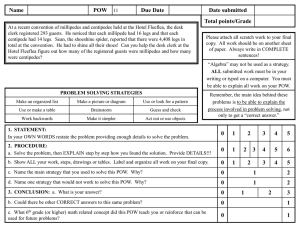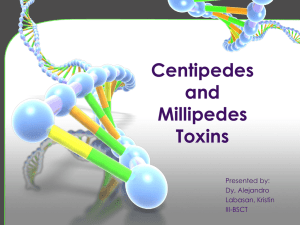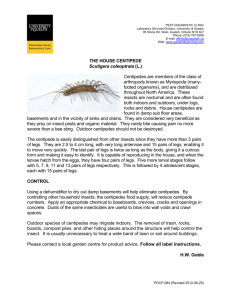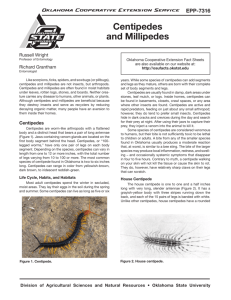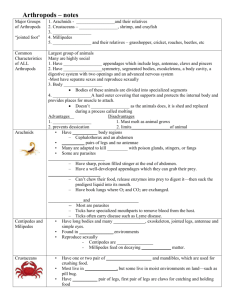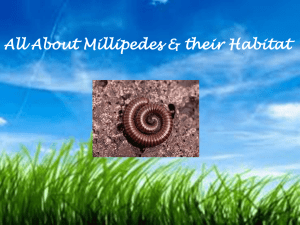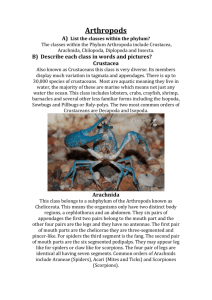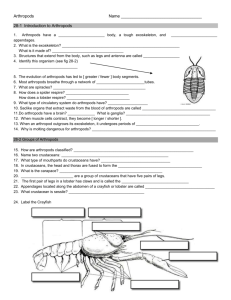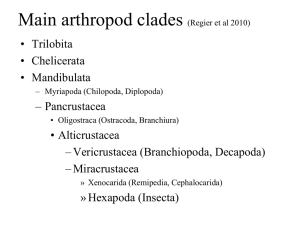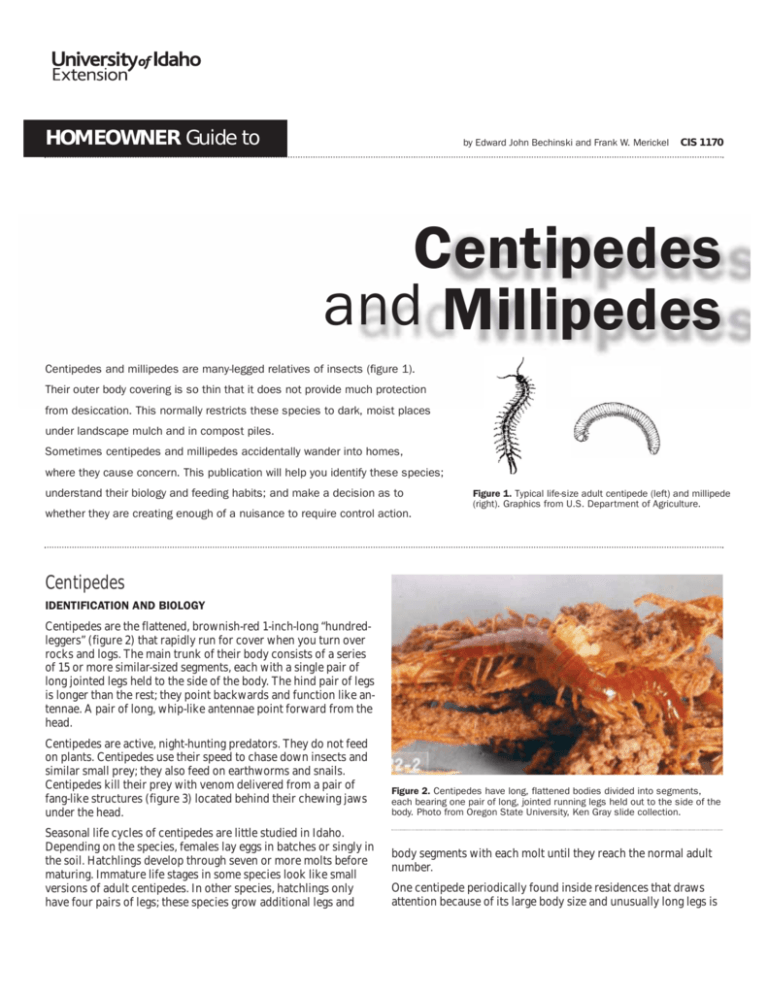
HOMEOWNER Guide to
by Edward John Bechinski and Frank W. Merickel
CIS 1170
Centipedes
and Millipedes
Centipedes and millipedes are many-legged relatives of insects (figure 1).
Their outer body covering is so thin that it does not provide much protection
from desiccation. This normally restricts these species to dark, moist places
under landscape mulch and in compost piles.
Sometimes centipedes and millipedes accidentally wander into homes,
where they cause concern. This publication will help you identify these species;
understand their biology and feeding habits; and make a decision as to
Figure 1. Typical life-size adult centipede (left) and millipede
(right). Graphics from U.S. Department of Agriculture.
whether they are creating enough of a nuisance to require control action.
Centipedes
IDENTIFICATION AND BIOLOGY
Centipedes are the flattened, brownish-red 1-inch-long “hundredleggers” (figure 2) that rapidly run for cover when you turn over
rocks and logs. The main trunk of their body consists of a series
of 15 or more similar-sized segments, each with a single pair of
long jointed legs held to the side of the body. The hind pair of legs
is longer than the rest; they point backwards and function like antennae. A pair of long, whip-like antennae point forward from the
head.
Centipedes are active, night-hunting predators. They do not feed
on plants. Centipedes use their speed to chase down insects and
similar small prey; they also feed on earthworms and snails.
Centipedes kill their prey with venom delivered from a pair of
fang-like structures (figure 3) located behind their chewing jaws
under the head.
Seasonal life cycles of centipedes are little studied in Idaho.
Depending on the species, females lay eggs in batches or singly in
the soil. Hatchlings develop through seven or more molts before
maturing. Immature life stages in some species look like small
versions of adult centipedes. In other species, hatchlings only
have four pairs of legs; these species grow additional legs and
Figure 2. Centipedes have long, flattened bodies divided into segments,
each bearing one pair of long, jointed running legs held out to the side of the
body. Photo from Oregon State University, Ken Gray slide collection.
body segments with each molt until they reach the normal adult
number.
One centipede periodically found inside residences that draws
attention because of its large body size and unusually long legs is
centipedes have poison jaws that are too small to puncture
human skin. Only the largest of our species could bite people,
and then only with pain no worse than a wasp sting. Common
sense dictates wearing gloves when working around the yard in
areas where any biting arthropod might be hiding. In general,
consider centipedes not as pests, but as natural predators that
are part of our backyard ecosystems.
Millipedes
IDENTIFICATION AND BIOLOGY
Figure 3. Centipedes are predators that kill small, soft-bodied prey with a
pair of poison fangs located under the head. Arrows point to the unusually
large poison fangs of a tropical (non-Idaho) species. Photo by Dennis
Schotzko, University of Idaho. All rights reserved.
Millipedes are the slow-moving “thousand-leggers” found in the
same damp, dark yard and garden habitats as centipedes. The
body of most millipedes consists of a series of ring-like, hard
cylindrical segments (figure 5), although some Idaho species
have flattened bodies rather than cylindrical bodies (figure 6).
The outer body covering is hardened by calcium that millipedes
accumulate when they eat decaying organic material. The crusty
white body shells seen on basement floors or trapped in garage
spider webs are the calcium-embedded exoskeletons that remain
after millipedes die.
Millipedes have a different leg structure and arrangement than
centipedes. Except for the first part of the body, every millipede
body segment bears 2 pairs of legs, whereas centipedes bear just
1 pair per body segment. Millipedes usually have short, hair-like
legs oriented directly under their body, rather than placed to the
side, as with centipedes. Another difference is that the antennae
of millipedes are so short they are hard to see with the naked eye.
Figure 4. The house centipede is about 2.5 inches long and has 15 pairs of
long, thin legs; its grey-tan body is marked with darker stripes that run down
the back. Photo by Dennis Schotzko, University of Idaho, all rights reserved.
Scutigera coleoptrata, the house centipede (figure 4). This fastrunning predator sometimes falls into empty sinks and bathtubs,
where the slippery surfaces prevent it from escaping. Contrary to
what some people say, house centipedes do not crawl up through
drains from inside household plumbing. Avoid the possibility of
bites by squashing them and rinsing down the drain, or removing
specimens with a vacuum cleaner. Toss the vacuum cleaner bag
in the trash after vacuuming, or empty the container into a bag,
close tightly, and dispose of outside.
PEST STATUS
Centipedes can potentially bite people with their poison jaws.
In tropical areas of Central and South America, large centipedes
can bite with burning pain. We believe that most Idaho
2 HOMEOWNER Guide to
Although one might think that having many legs would allow
millipedes to run with speed, they instead crawl slowly but
powerfully over the soil surface, pushing head-first like
bulldozers through leaf litter and loose soft soil. Millipedes flex
their legs with a progressive wave-like motion in which the legs
on one side of a body segment simultaneously move forward
with the legs on the other side of that body segment.
In contrast, the rapid gait of centipedes is due in part to their
alternating stepping pattern, in which the forward motion of a
leg on one side of a body segment is matched by the backwards
motion of the leg on the other side. Many millipedes curl into a
“C” shape and remain motionless when disturbed.
Millipedes have a pair of jaws they use to feed on dead, decaying
plant material on the soil surface. Ecologically, millipedes are like
earthworms, recycling plant nutrients back into the soil.
Millipede eggs are laid in the soil, and hatchlings develop through
as many as 10 molts over one to five years before reaching
adulthood. Immatures have fewer body segments and legs than
adults. They add body length and legs with each molt. Adult
millipedes live two years or longer.
PEST STATUS
Millipedes do not bite, and entirely lack venom. Vividly colored
species (figure 7) can produce droplets of obnoxious-smelling
defensive chemicals that perhaps could raise a small dark blister
on tender skin, but these species seldom are encountered around
the home. Outside the home, millipedes sometimes feed on
tender shoots and roots of living seedling plants, but they
generally should be considered beneficial recyclers in the garden.
Inside the home they almost always are limited to lone accidental
invaders. They also occur in rooms where there are lots of potted
houseplants.
Figure 5. Commonly encountered millipedes in Idaho have cylindrical, multisegmented bodies with dozens of short, hair-like legs directly under the body
trunk. Photo from Oregon State University, Ken Gray slide collection.
One bark-inhabiting millipede, the bristly millipede (known by
the scientific name Polyxenus), periodically wanders by the
hundreds into homes during the first warm days of spring after
snow melt, or in the fall following rainy weather. At first glance,
this 1/8-inch long species looks more like a beetle grub than a
millipede (figure 8). But whereas beetle grubs always have three
pairs of legs, the bristly millipede has 13 pairs of legs.
Under magnification, tufts of needle-like bristles can be seen in
rows along the body. Two brushes of detachable, barbed hairs
extend from the end of the body. Like the quills on a porcupine,
these are defensive structures that the millipede swipes against
attacking predators (such as ants) to kill them. These hairs
could potentially irritate human skin.
Bristly millipedes normally live unnoticed outside under loose
bark flakes on trunks of conifers and broadleaved trees, where
they feed on algae and lichens. One species seems to be
associated with ant nests. Inside homes they typically are noticed
crawling on walls and ceilings of basements (both finished and
unfinished rooms) or other ground-level rooms with windows
that extend to the soil surface. They do not reproduce inside
homes. Any specimens found inside are accidental invaders that
originated from adjacent outdoor landscapes.
Figure 6. Some millipedes have flattened rather than rounded bodies. Photo
by Dennis Schotzko, University of Idaho. All rights reserved.
Management
DEALING WITH NUISANCE PROBLEMS INSIDE THE HOME
The presence of centipedes and millipedes inside your home can
be a nuisance. However, these creatures are not dangerous or
harmful to people, pets, stored foods, houseplants, furniture, or
home structural timbers. Unless they can find damp areas, none
can survive inside the home for more than a few days. And even
in high moisture areas, unless they also find food in the form of
either plant debris (for millipedes) or living insects (for centipedes), none can establish permanent, reproducing populations
in the dry, light living quarters of homes.
Damp, unfinished crawlspaces and basements sometimes harbor
centipedes and millipedes. They sometimes occur in bathrooms
under sink cabinets, as well as in sunrooms with lots of potted
houseplants.
Figure 7. Millipedes marked in vivid warning colors (such as this mating pair
of yellow-spotted millipedes that live in the forests of northern Idaho) secrete droplets of toxic chemicals that can produce a small discolored spot
on bare skin. Photo by Dennis Schotzko, University of Idaho. All rights reserved.
When the weather is warm, individual specimens accidentally
crawl into the living quarters of homes under loose-fitting doors
and basement windows. This is especially true when physical
disturbance or overwatering of outdoor landscape beds next to
homes causes them to temporarily abandon these hiding sites.
Centipedes and Millipedes 3
your home from outdoors. Insecticides cannot substitute for
elimination of outdoor breeding sites and exclusion of pest
entry by sealing doors and windows. This is especially true for
nuisance problems inside garages and sheds.
Figure 8. The bristly millipede at pencil point (left) is a tiny fuzzy species that
sometimes appears in large numbers inside homes. Magnified view (right)
shows fine needle-like hairs arranged in bunches, and two thicker brushes at
the tip of the body. Photo by Edward John Bechinski, University of Idaho.
Single individuals also sometimes are seen in the middle of
winter inside homes. These inevitably were carried into the
home on firewood stacked outside.
The key to dealing with centipedes and millipedes is to minimize
the high moisture conditions these groups require to survive.
This is true for managing pest problems inside the home as well
as minimizing plant-feeding damage in gardens.
ELIMINATE OUTDOOR HABITATS IMMEDIATELY next to homes.
Problems usually begin immediately outside the home in moist
plant beds along the foundation. Do whatever you can to dry
out these areas and remove ground clutter that shelter these
pests. Bark mulch and vining ground covers are common sources
of problems.
Millipedes and centipedes can live among wet firewood with
loose bark. Stack firewood on raised concrete pads off the soil
surface to minimize population build-up during the summer,
and shake off individuals clinging to firewood before bringing it
inside during the winter.
SEAL DOOR THRESHOLDS AND BASEMENT WINDOWS TO
PREVENT ENTRY. Any opening in exterior walls can allow pests to
enter your home. Loose-fitting sliding patio doors next to flower
beds, basement windows (especially those next to window
wells), and foundation vents allow for easy inside access.
If you do decide to use an insecticide, look for products that
specifically say on the label that they are for outdoor perimeter
barrier applications along home foundations to kill home
invading pests. Products that contain any one of the following
pest-killing active ingredients should be equally effective as
foundation sprays against centipedes and millipedes: betacyfluthrin (b-cyfluthrin), bifenthrin, carbaryl, cyfluthrin,
cypermethrin, deltamethrin, esfenvalerate, gamma cyhalothrin,
lambda-cyhalothrin, and permethrin. These pest-killing chemicals
are sold under dozens of different commercial trade names.
All of these chemicals are broad-acting nerve poisons that kill
both by direct contact with the wet spray, and when pests crawl
over the dry but treated surface. A single spray of any one of
these products should provide immediate control that lasts at
least 10-14 days.
The US-EPA classifies most of these home barrier products as
slightly toxic to people by inhalation, skin contact or ingestion;
these have the word CAUTION printed on the label, which designates the lowest (least toxic) EPA category. A few are moderately
toxic to people; these say WARNING on the label. None of the
homeowner products are designated by the word DANGER,
which identifies products that can seriously burn skin or eyes.
!
DO NOT SPRAY any yard and garden plants – especially
vegetable plants, berries, and fruits for human consumption -unless the pesticide label specifically lists your plant.
DO NOT SPRAY FIREWOOD. Treated logs may produce toxic
fumes when burned.
NEVER USE YARD AND GARDEN PESTICIDES INSIDE YOUR
HOME unless the pesticide label states the chemical is safe
for indoor use.
VENTILATE BASEMENTS AND CRAWLSPACES. Damp cellars with
freshly stored potatoes or organic debris can offer breeding sites
for millipedes. These species in turn provide food for centipedes
as well as spiders. Clean up and dry out those spaces.
PHYSICALLY REMOVE INDOOR SPECIMENS. Vacuum up, squash and
toss, or capture and release outside the few individuals that
crawl into your home. There is no need for immediate indoor
insecticide treatment to eliminate the occasional individual
specimen.
Unless otherwise directed by the label, spray a 1 or 2-foot wide
continuous band of insecticides on the soil outside around the
building foundation, spraying upwards on the exterior
foundation another 2 feet. Spray around doors, windows, utility
line entrances, vents, and other exterior-wall openings.
APPLY PESTICIDES AS OUTDOOR PERIMETER SPRAYS ON HOME
FOUNDATIONS. Only apply pesticides as a stop-gap measure when
intolerable numbers of millipedes and centipedes are entering
It is neither necessary nor desirable to spray entire landscape
beds. Broad-scale sprays kill pest and beneficial species alike,
including earthworms, lady beetles, and pollinators. Indeed,
4 HOMEOWNER Guide to
when centipedes and millipedes remain outside the home,
they too are best considered beneficial species.
“Least-toxic” alternatives to broad-acting pesticides include diatomaceous earth and plant-derived botanical insecticides. These
products pose reduced risks to people, pets, and wildlife, but are
not necessarily less toxic to beneficial insects and earthworms.
All of these products have limited usefulness as outdoor barrier
treatments for home-invading pests. Only three diatomaceous
earth products are available to homeowners for outdoor use:
Safer Brand Ant & Insect Killer, Natural Guard Crawling Insect
Control, and Concern Diatomaceous Crawling Insect Killer.
These should be applied as a light, dry dust to patios, window
wells, and around door thresholds.
Plant extracts include pyrethrin (which is sold under many
different commercial trade names) and the GreenLight Bioganic
product line of clove, thyme, and sesame-oil sprays. Botanicals
can kill when centipedes and millipedes come into direct
contact with the wet spray, but these natural pesticides quickly
evaporate, break down, and disappear.
For all but exceptional cases of massive numbers of invading
pests, we recommend against indoor pesticide use for centipedes
and millipedes. It is more cost-effective and less hazardous to
you, your family, and your pets to only use pesticides as exterior
perimeter sprays.
DEALING WITH PLANT-FEEDING MILLIPEDES IN GARDENS
AND FRUIT BEDS
Millipedes usually only feed on dead, decaying plant debris, but
are known to occasionally feed on the lower leaves of tender garden seedlings and on over-ripe berries or vegetables that directly
rest on damp soils. Feeding damage normally is inconsequential.
Populations sometimes build up in backyard and commercial
greenhouses, where their plant-feeding can be more significant.
Centipedes never damage plants; they only eat living prey,
not plants.
Minimize breeding sites. Water plants early in the day so that the
soil surface dries by night, when millipedes are most active. Avoid
heavy organic mulches that shelter pests early in the season, when
!
ONLY USE BAITS TO PROTECT PLANTS SPECIFICALLY NAMED
ON THE LABEL. If your plant is not listed, you have the wrong
product. DO NOT USE IT.
NEVER ALLOW BAITS TO CONTACT ANY PORTION OF THE
PLANT. Toxic residues otherwise might transfer to edible produce.
small, succulent plants are most susceptible to feeding injury.
Ripe strawberry fruits on straw beds, and maturing vegetables like
cucumbers that rest on the soil, can be susceptible. Whatever you
can do to raise produce off the ground will reduce feeding.
Use dry pesticide baits if feeding damage is severe. Millipedes are best considered beneficial decomposers and recyclers
of plant nutrients. Only use pesticides if they are causing severe
feeding damage to young seedlings or ripening fruits.
If you decide that pesticides are needed, we recommend using
insecticide baits rather than plant-applied sprays. Baits consist
of flakes or pellets of food materials impregnated with insecticide. These are scattered on the soil next to (but not touching)
plants, where they only kill pests that eat the bait. Because they
must be eaten to be effective, baits are less ecologically disruptive to beneficials than sprays that kill by contact. Look for baits
that specifically say on the label that they can be applied around
garden vegetables and berries for millipede control.
Table 1 lists some representative bait products and the garden
crops on which those products legally can be used. Many baits
combine one chemical that kills millipedes with another chemical
that kills slugs and snails. Baits that only list slugs and snails on
the label as target pests do not control millipedes. These baits
only contain metaldehyde or iron phosphate as the active
ingredient, both of which are specific in their killing action to
slugs and snails.
Centipedes and Millipedes 5
Table 1. Widely available baits for control of pillbugs and sowbugs in home vegetable gardens and berry patches.
product name(s)
manufacturer
active ingredient(s)
label signal words
asparagus
beans
beets
broccoli
Brussels sprouts
cabbage
carrots
cauliflower
celery
Chinese cabbage
collards
corn
cucumber
eggplant
garlic
kale
kohlrabi
lettuce
melons
onion
parsnip
peas
peppers
potatoes
radishes
rutabagas
soybean
spinach
squash
Swiss chard
tomato
turnip
berries -strawberries
Bug Bait*
Corry's Bug Bait*
Corry's Insect Killer*
Deadline Bug Bait*
Green Light
carbaryl
metaldehyde
caution
Cooke Pest Granules*
Go-West Meal*
Slug, Snail, &
Insect Killer Bait*
Lilly Miller
carbaryl
metaldehyde
caution
Ortho Bug-Geta Plus
Snail, Slug & Insect Killer*
Sluggo Plus*
caution
Ortho
carbaryl
metaldehyde
caution
Monterey
spinosad
iron phosphate
caution
NO
YES
YES
NO
NO
YES
NO
NO
NO
NO
NO
NO
NO
YES
NO
NO
NO
YES
NO
NO
NO
NO
NO
YES
NO
NO
NO
YES
NO
NO
YES
YES
YES
YES
NO
NO
NO
YES
YES
NO
YES
NO
NO
NO
YES
NO
NO
NO
NO
YES
YES
NO
NO
YES
YES
YES
YES
NO
NO
YES
YES
NO
YES
YES
YES
YES
NO
NO
NO
YES
YES
NO
YES
NO
NO
NO
YES
NO
NO
NO
NO
YES
YES
NO
NO
YES
YES
YES
YES
NO
NO
YES
YES
NO
YES
YES
YES
YES
YES
YES
YES
YES
YES
YES
YES
YES
YES
YES
YES
YES
NO
YES
YES
YES
YES
NO
YES
NO
YES
YES
YES
YES
NO
NO
YES
YES
YES
YES
NO
YES
YES
YES
YES
YES
YES
YES
NO
YES
YES
YES
YES
YES
NO
YES
YES
YES
YES
NO
YES
YES
YES
YES
YES
YES
NO
YES
YES
YES
YES
YES
YES
YES
YES
YES
YES
YES
YES
YES
NO
NO
NO
YES
YES
YES
YES
NO
NO
YES
YES
YES
YES
YES
YES
YES
YES
YES
YES
YES
YES
YES
YES
YES
YES
YES
YES
YES
YES
YES
Matson
carbaryl
metaldehyde
caution
Earwig & Sowbug Bait
Grasshopper, Earwig,
Cutworm & Sowbug Bait
Lilly Miller
carbaryl
*product also kills slugs and snails in addition to millipedes
NOTE: YES designates products that legally can be applied on the soil next to the listed plant; NO designates uses that are illegal and potentially hazardous
because the pesticide label does not include that particular plant. NEVER ALLOW THESE BAITS TO CONTACT PLANTS; only apply baits to the soil surface as
directed by the label.
About the authors:
EDWARD JOHN BECHINSKI is a University of Idaho professor of entomology and coordinator of pest management for University of Idaho Extension.
FRANK W. MERICKEL is the manager of the Barr Entomological Museum at the College of Agricultural and Life Sciences, University of Idaho.
ALWAYS read and follow the instructions printed on the pesticide label. The pesticide recommendations in this UI publication do not substitute for
instructions on the label. Due to constantly changing pesticide laws and labels, some pesticides may have been cancelled or had certain uses
prohibited. Use pesticides with care. Do not use a pesticide unless both the pest and the plant, animal, or other application site are specifically
listed on the label. Store pesticides in their original containers and keep them out of the reach of children, pets, and livestock. Trade names are
used to simplify the information; no endorsement or discrimination is intended.
Issued in furtherance of cooperative extension work in agriculture and home economics, Acts of May 8 and June 30, 1914, in cooperation with the U.S.
Department of Agriculture, Charlotte V. Eberlein, Director of University of Idaho Extension, University of Idaho, Moscow, Idaho 83844. The University of Idaho
provides equal opportunity in education and employment on the basis of race, color, national origin, religion, sex, sexual orientation, age, disability, or status
as a disabled veteran or Vietnam-era veteran, as required by state and federal laws.
Published November 2009
© 2009 University of Idaho

